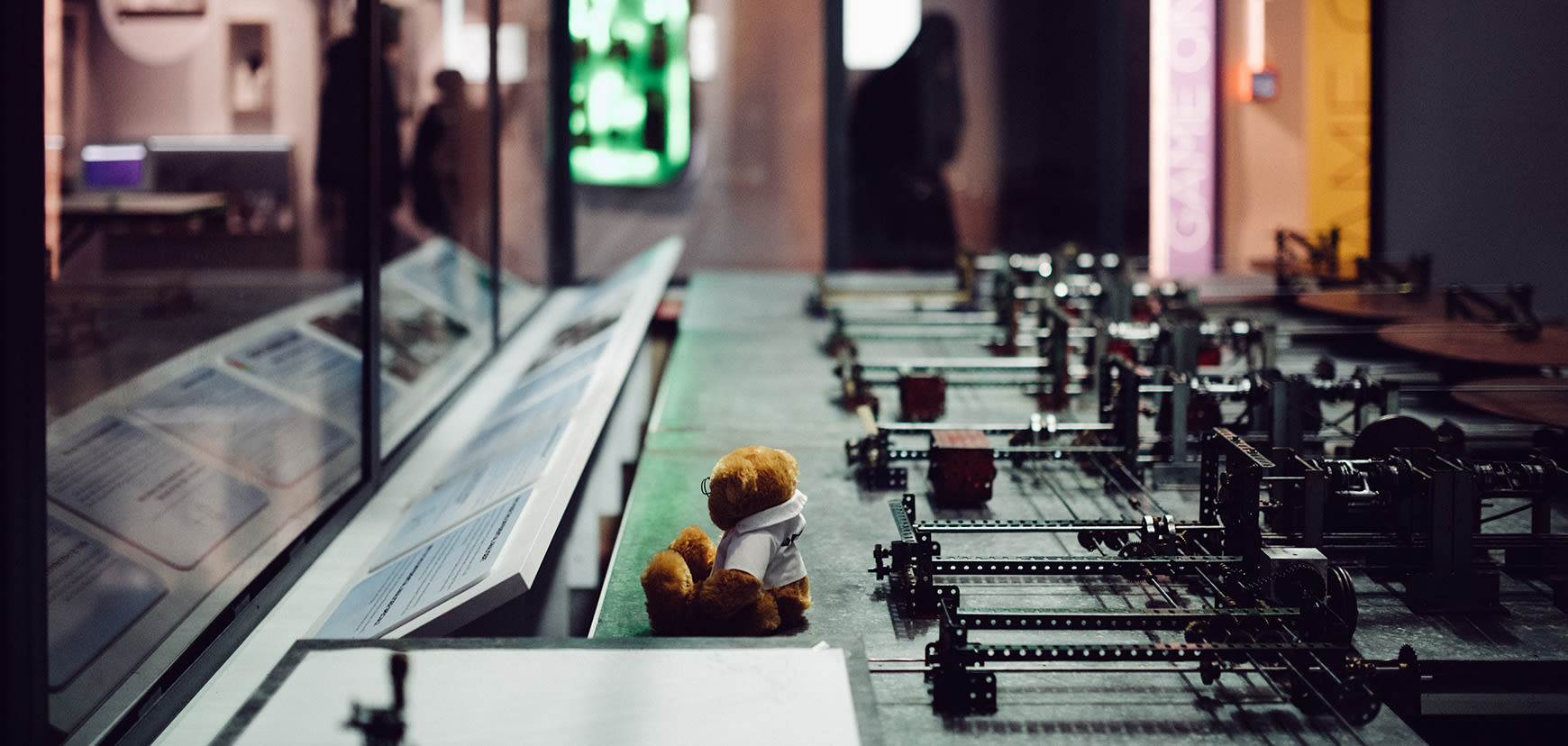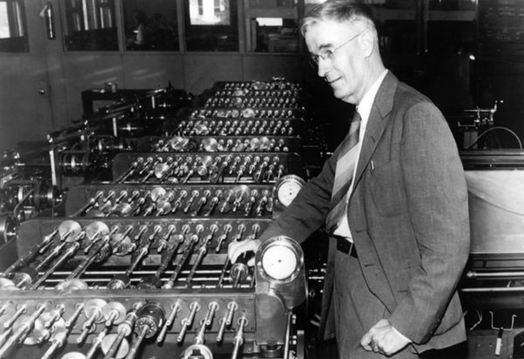A Meccano computer: MOTAT’s differential analyser

A mechanical analogue computer built from Meccano in the 1930s to solve complicated differential equations? Yes, MOTAT has one of those.
‘Our machine is the most accurate Meccano-based differential analyser built and now it’s the only one left.’
What is a differential analyser?
A differential analyser is a mechanical or electronic analogue computer used to solve especially complicated differential equations.
Here’s an example of a differential equation


The Cambridge Meccano differential analyser held at MOTAT
The example at MOTAT, which is the Cambridge [University] Meccano differential analyser, is a mechanical analogue computer which solves differential equations by integration. It makes use of one or more wheel and disc integrators, interconnected by shafts in various ways to suit the problem equations.
About 15 Meccano-based differential analysers, as well as many full-scale differential analysers, were built in the USA, UK and Europe between 1934 and the early 1950s. They were eventually replaced by electronic analogue computers and then, later, by digital computers.
William Irwin, who was interviewed for MOTAT’s Walsh Memorial Library oral history programme, explains how differential analysers came to be built:
‘Vannevar Bush, a professor at MIT [Massachusetts Institute of Technology] wanted to solve differential equations. Now, remember, in those days there weren’t computers like we have today. Everything had to be done by hand or with mechanical devices — adding machines, etc. A complicated differential equation, you perhaps couldn’t solve at all, or you could with a lot of manual labour with paper and pencil and calculations and adding and subtracting on these hand calculating machines.

Vannevar Bush, 1890–1974, with his differential analyser at MIT
‘[Bush] invented this machine by linking up several integrators … . He heard of a guy who had invented a thing called a torque amplifier. [Bush] … inserted one of these torque amplifiers at the end of each integrator, on the outward side. These torque amplifiers consisted of little … stainless steel drums, round which bands were turned — usually of cotton or some other thicker material. … It’s called the capstan principle. … He managed to get six, eight integrators in line, joined up, using these torque amplifiers.’ Bush built his differential analyser in about 1930.
Where was MOTAT’s Meccano differential analyser made?
William Irwin was asked who had the idea of making one from Meccano.
‘Everyone from all over the world was going off to Massachusetts to see this wonderful machine that Vannevar Bush had built. Among them was Douglas Hartree from Manchester University. He was a … physicist doing atomic research. … He was quite impressed with this machine and he came back to England and told his assistant, Arthur Porter that it looked like someone had been playing with a giant Meccano set. So he … got out his own Meccano set and Arthur Porter brought a lot of Meccano that he had, and they bought a few more bits, and they thought, Let’s try and mock one up out of Meccano. … The torque amplifier part they gave to their machine shop to build — and they put something together — just one integrator — and they managed to get it to work. Then they decided, Well, let’s go on, and they built that one you see here in the Meccano magazine of June 1934 [p. 441]. … There were three integrators, single-stage torque amplifier. It wasn’t all that accurate, but it worked and that was proof enough for the authorities to spend the money on a big full-scale … differential analyser at Manchester [University]. It was built by Metropolitan-Vickers, the company which made aeroplanes. That was the first full-scale and Meccano-based one built in England. That was 1934, and ’35 for the full-scale one.’

Meccano Magazine, June 1934
‘The only thing which couldn’t be done in Meccano properly were the torque amplifiers and these were machined in the university’s workshop, both on the Manchester one and the Cambridge machine that we have here in MOTAT. Ours are very sophisticated ones. They are two-stage torque amplifiers … . These drums are driven independently by separate motors underneath, so the force, or the torque, comes from these motors … .’
‘[Scientists] at Cambridge got to hear about this and they invited Hartree over to give them a lecture. … Professor [John] Lennard-Jones was a professor of Chemistry, but he was also involved in the computation side. At Cambridge they had a mathematics laboratory. They decided to build [a differential analyser] and Lennard-Jones got a guy called J.B. Bratt. … He had been a clockmaker … He built the one we have — the one which came to Auckland — and improved over [the earlier] one because the second time around they used two-stage torque amplifiers, for instance, and there were other improvements to such an extent that the accuracy of our Meccano one approached the accuracy of the full-scale one. … It was pretty accurate because they built in all sorts of anti-backlash mechanisms which is very interesting for us to see now, looking at the ancient machine. We were quite thrilled when we first examined it. … Our machine is the most accurate Meccano-based differential analyser built and now, of course, it’s the only one left.’

MOTAT’s differential analyser in use at the Cambridge University Mathematics Laboratory, in around 1937. On the right is Dr Maurice Wilkes, 1913–2010, who was responsible for the differential analyser at this time
How was it set up?
William Irwin explained:
‘To solve a complicated differential equation, it might take two weeks for the guy to decide how the machine had to be set up for that particular equation … and however many integrators were required. With the Meccano one you got your screwdriver … [and] set the thing up in a certain way. Which gears mesh with which other gears, etcetera. Adding units.
‘That might take about a week. The set up.
‘Then a few runs to see if you’re in the right ballpark. Then OK, you’re ready. You set it going and you get a plot on the graph paper from which you can scale a few answers. You might spend another week playing around with different answers — if we change the input to this, we get that, etcetera. So, it might take two weeks and they’ve got their problem solved, compared to a couple of months the hand way. It was a tremendous saving for the people at that time.’
How did it come to New Zealand?
Henry (Harry) Whale graduated from Auckland University College in 1943. He began his professional life with the Department of Scientific and Industrial Research (DSIR) in 1944 on electronic development and radio communication studies. From 1947 he worked in the Radio Section of the Cavendish Laboratory, Cambridge University on the design, construction and operation of an ionosonde and antenna system for the study of the fine structure of the E Region of the ionosphere. He completed his PhD at Cambridge in 1950. In 1951, he returned to New Zealand to set up the Seagrove Radio Research Station on the southern coast of Auckland’s Manukau Harbour, where he held the post of Director. Seagrove was a part of the University of Auckland’s Physics Department. In 1959 Whale took up a research position with NASA at the Wallops Island Launch Site, Virginia. In 1962 he returned to Seagrove, and in 1966 was appointed to a Personal Chair in the Faculty of Science at the University of Auckland. From 1969 until his retirement in 1982, he held a variety of teaching and research posts in the United States, Germany and New Zealand.
It was Harry Whale who was responsible for the arrival of the Meccano differential analyser in New Zealand after he bought it for the Seagrove Radio Research Station in 1950. He had used it while he was working at Cambridge’s Cavendish Laboratory in the late 1940s. Whale paid £100 for it: ‘I got it in Cambridge,’ he said, ‘because it was offered to me’. Once it was no longer needed at Seagrove, Whale sold it to the Department of Scientific & Industrial Research’s [DSIR] Applied Mathematics Laboratory where it was used until 1961.
What was it used for here?
Once it came to New Zealand, it was used by Harry Whale at Seagrove Radio Research Station.
At the DSIR, the differential analyser was used to predict results in areas such as geothermal studies, Waikato river hydro-electric scheme studies, the Lake Grassmere saltworks design, and rabbit population predictions.
How it came to MOTAT
From the DSIR, the differential analyser went to the Wellington Polytechnic where it was used for teaching before being put into storage. In 1973 it was rediscovered by the Wellington Polytechnic principal, donated to MOTAT and shipped to Auckland, where Harry Whale, assisted by two students, Kevin Ryan and Darcy Millar, got it operational again for demonstration purposes and it was on display in an exhibition of early computer technology until the early 1980s.

The Cambridge Meccano differential analyser in an exhibition at MOTAT
Part 2 of this blog will deal with the conservation of the differential analyser after it came to MOTAT.
REFERENCES:
J. Crank. 1947. The differential analyser, PUB-2019–8. Walsh Memorial Library, The Museum of Transport and Technology (MOTAT) https://collection.motat.org.nz/objects/110260
Walsh Memorial Library, MOTAT: Ring binder, articles and notes from various sources about the differential analyser https://collection.motat.org.nz/objects/56907
William Irwin et al. 08 Sep 2015; 22 Sep 2015. MOTAT oral history interview with William Irwin, 16–0540. Walsh Memorial Library, The Museum of Transport and Technology (MOTAT) https://collection.motat.org.nz/objects/92718
Harry Whale et al. 15 Nov 2003–28 Feb 2004. MOTAT oral history interview with H. Whale, 07–528. Walsh Memorial Library, The Museum of Transport and Technology (MOTAT) https://collection.motat.org.nz/objects/43414
CITE THIS ARTICLE:
Hutching, Megan. A Meccano computer: MOTAT’s differential analyser MOTAT Museum of Transport and Technology. First published: 08 September 2020. URL www.motat.nz/collections-and-stories/stories/a-meccano-computer-motats-differential-analyser